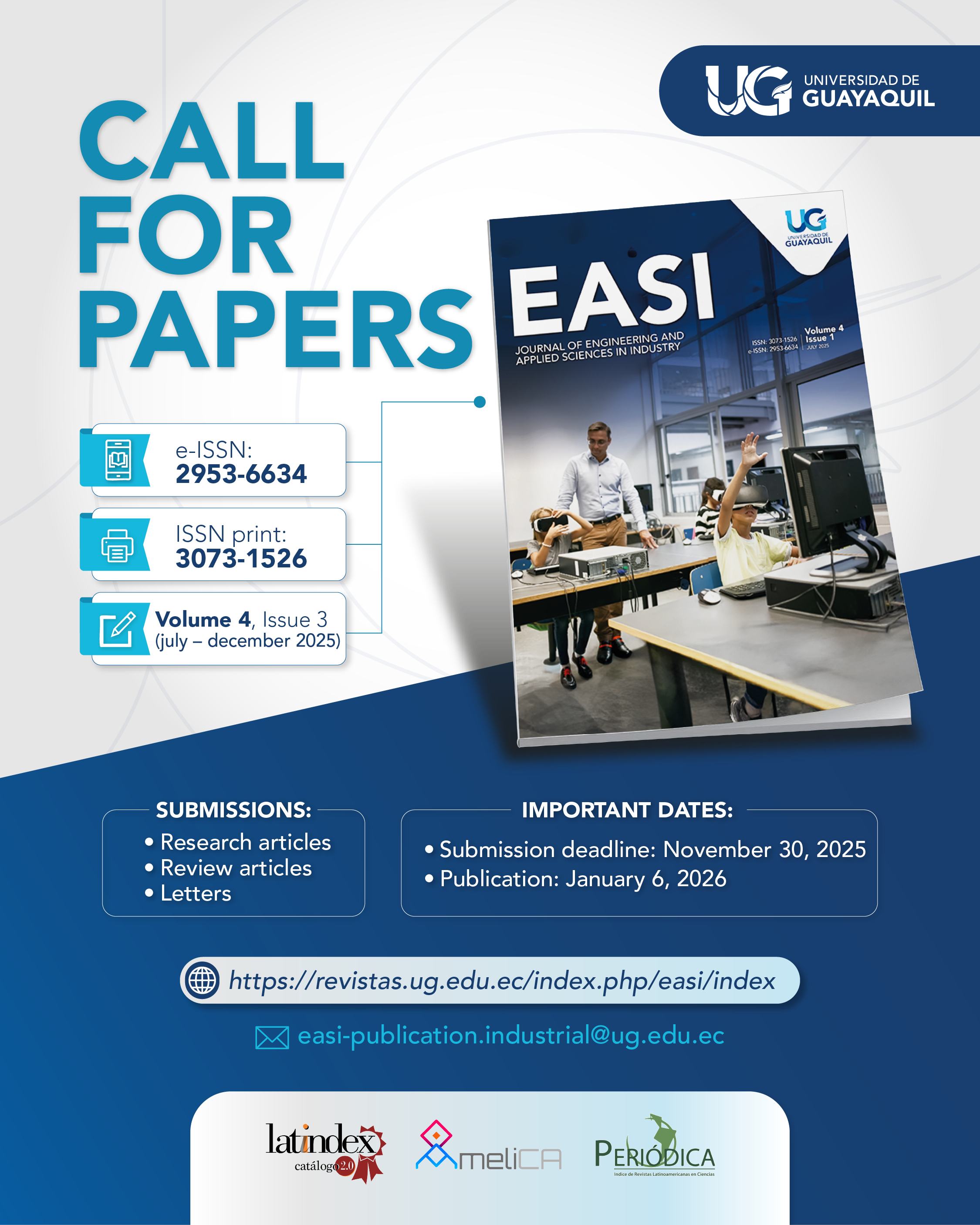Design and implementation of a mechatronic system for monitoring worker exposure in cold storage facilities
DOI:
https://doi.org/10.53591/easi.v3i1.0302Keywords:
Mechatronic System, Occupational Safety, Cold Storage Monitoring, Time Control DeviceAbstract
In response to the increasing need for enhanced occupational safety in cold storage facilities, this study presents the design and validation of a mechatronic time control device specifically developed for monitoring the exposure times of warehouse operators in a multinational company. Over the past two decades, Ecuador has significantly increased regulations to safeguard worker health and safety. In compliance with these regulations, this research addresses the challenges operators face when exposed to sub-zero temperatures during their work shifts. The proposed system integrates mechanical, electronic, and control components to systematically track and manage operators' time within cold rooms, ensuring compliance with predefined safety thresholds. A NodeMCU microcontroller, digital temperature sensors, and a robust communication interface form the device's core. This device records entry and exit times, monitors ambient conditions, and triggers alerts when exposure limits are approached. Extensive validation was conducted using a 3D-printed resin prototype, demonstrating the device's capability to function effectively in harsh environments. The system's efficacy was evaluated through real-world testing, where operators used the prototype during their shifts. Data collected confirmed the device's reliability in tracking exposure times and enhancing worker safety.
References
BSIGroup. (2024). Getting started with BS OHSAS 18001 Occupational Health and Safety Management. https://www.bsigroup.com/en-CA/BS-OHSAS-18001-Occupational-Health-and-Safety/Introduction-to-BS-OHSAS-18001/.
Cámara, J. (2016). Desarrollo de interfaces para Arduino en Visual C++. https://riubu.ubu.es/bitstream/handle/10259/3982/Desarrollo%20de%20interfaces%20para%20Arduino%20UNO%20en%20visual%20C++.pdf
Creality (2024). Creality3D ld-006h resin 3D printer. Creality 3D. https://www.creality.com/products/creality-ld-006-resin-3d-printer
Grupo Kalise Menorquina. (2018). La Cadena de Frío en los helados. https://xdoc.mx/documents/la-cadena-de-frio-en-los-helados-5f402de7ec675#:~:text=LA%20CADENA%20DE%20FR%C3%8DO%20EN,esta%20forma%2C%20su%20buen%20estado
Lakatos, D. (2020). Guía de impresión 3D: Tipos de impresoras 3D, materiales y aplicaciones. Formlabs. https://formlabs.com/latam/3d-printers/.
Ministerio del Trabajo. (2024). https://www.trabajo.gob.ec/direccion-de-seguridad-en-el-trabajo-y-prevencion-de-riesgos-laborales/.
Netwoods, G. N. W. (2024). Control de entradas y salidas de trabajadores. https://www.visitentry.com/es-EC/asistencia-empleados
OSHA. (2023). Department of Labor Logo United States department of Labor. Occupational Safety and Health Administration. https://www.osha.gov/winter-weather/cold-stress
Roobuck (2024). Mine IoT Solutions and Devices. Roobuck. https://roobuck.co/roobuck-solutions-wireless-tracking-and-signalling-solution-for-underground-hardrock-mines/
Chen, J., Fu, Y., Lu, W., & Pan, Y. (2023). Augmented reality-enabled human-robot collaboration to balance construction waste sorting efficiency and occupational safety and health. Journal of Environmental Management, 348, 119341. https://doi.org/10.1016/j.jenvman.2023.119341
Díez, C. (2020). Un Sistema Inteligente de Monitorización reduce Los Accidentes laborales y Mejora La Eficiencia en la construcción. Plataforma enerTIC.org. https://enertic.org/un-sistema-inteligente-de-monitorizacion-reduce-los-accidentes-laborales-y-mejora-la-eficiencia-en-la-construccion/.
Ding, J., Weng, J., & Chou, C. (2023). Assessment of key risk factors in the cold chain logistics operations of container carriers using best worst method. International Journal of Refrigeration, 153, 116–126. https://doi.org/10.1016/j.ijrefrig.2023.06.013
Espresssif Systems IOT Team. (2022a). 0A-Esp8266 datasheet en v4.3 - components101. https://www.espressif.com/sites/default/files/documentation/0a-esp8266ex_datasheet_en.pdf
Espresssif Systems IOT Team (2022b). SSD1306 - Datasheet Hub. https://datasheethub.com/wp-content/uploads/2022/08/SSD1306.pdf
IESS. (2020). Boletín Estadístico del IESS Año 2020. Instituto Ecuatoriano de Seguridad Social, IESS. Dirección Actuarial, de Investigación y Estadística. https://www.iess.gob.ec/documents/10162/8421754/10_BOLETIN_ESTADISTICO_25_2020?version=1.2
Pistolesi, F., Baldassini, M., & Lazzerini, B. (2024). A human-centric system combining smartwatch and LiDAR data to assess the risk of musculoskeletal disorders and improve ergonomics of Industry 5.0 manufacturing workers. Computers in Industry, 155, 104042. https://doi.org/10.1016/j.compind.2023.104042
Romo, S. (2014). El frío, un riesgo laboral. Revista Cero Grados. https://0grados.com/el-frio-un-riesgo-laboral/#:~:text=La%20actividad%20en%20lugares%20fr%C3%ADos,con%20la%20vida%20del%20trabajador.
Son, H., & Kim, C. (2021). Integrated worker detection and tracking for the safe operation of construction machinery. Automation in Construction, 126, 103670. https://doi.org/10.1016/j.autcon.2021.103670
Toro, J. L., Comas R., Castro F. (2020). Normativa en seguridad y salud ocupacional en el Ecuador. Universidad y Sociedad, 12 [S(1)], 497-503. https://rus.ucf.edu.cu/index.php/rus/article/view/1887
Vasco, P. C., Calderón, D. Á., Salazar, P. M., & Garcia, A. G. (2018). Occupational safety and health in Ecuador. INNOVA Research Journal, 2(12), 139–152. https://doi.org/10.33890/innova.v2.n12.2017.322
Walters, D. (2024). Professions, power and paradox in occupational safety and health in the 21st century. Safety Science, 174, 106446. https://doi.org/10.1016/j.ssci.2024.106446
Published
Issue
Section
License
Copyright (c) 2024 Marcelo Fajardo-Pruna, Luis Lopez-Estrada, Jhon Barbery, Guillermo Medina

This work is licensed under a Creative Commons Attribution-NonCommercial-NoDerivatives 4.0 International License.
Contributions published in the EASI journal follow the open access license CC BY-NC-ND 4.0 (Creative Commons Attribution-NonCommercial-NoDerivs 4.0). This license empowers you as an author and ensures wide dissemination of your research while still protecting your rights.
For authors:
- Authors retain copyrights without restrictions according to CC BY-NC-ND 4.0 license.
- The journal obtains a license to publish the first original manuscript.
For readers/users:
Free access and distribution: Anyone can access, download, copy, print, and share the published article freely according to the license CC BY-NC-ND 4.0 terms.
Attribution required: If any third party use the published material, they must give credit to the creator by providing the name, article title, and journal name, ensuring the intellectual property of the author(s), and helping to build the scholarly reputation.
Non-commercial use: only noncommercial use of the published work is permitted. Noncommercial means not primarily intended for or directed towards commercial advantage or monetary compensation by any third party.
No modifications allowed: The content of the published article cannot be changed, remixed, or rebuilt upon the author’s work. This ensures the integrity and accuracy of the research findings.










